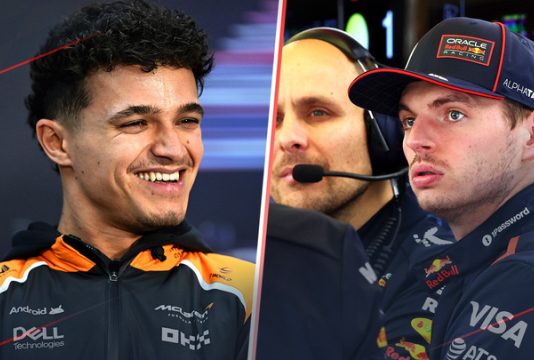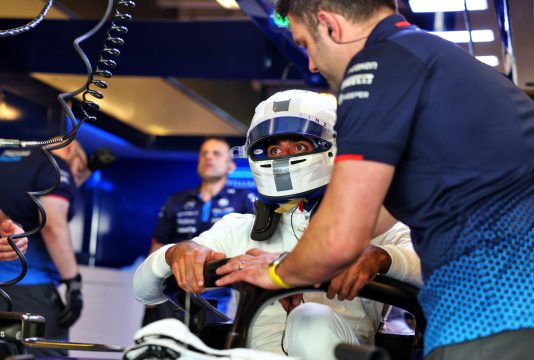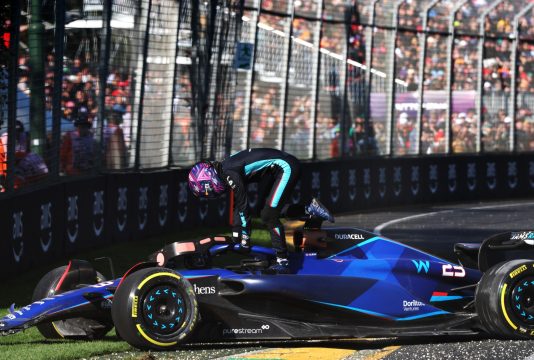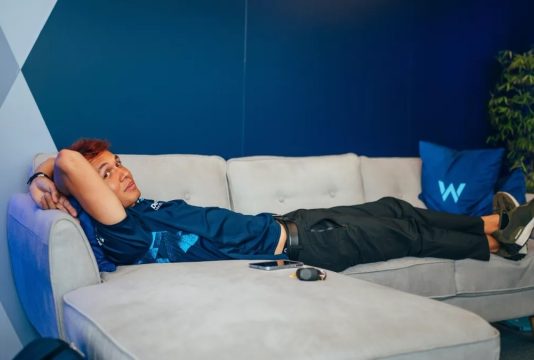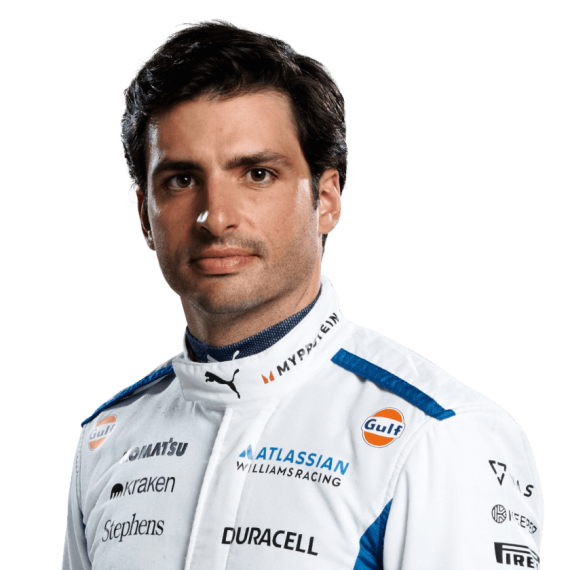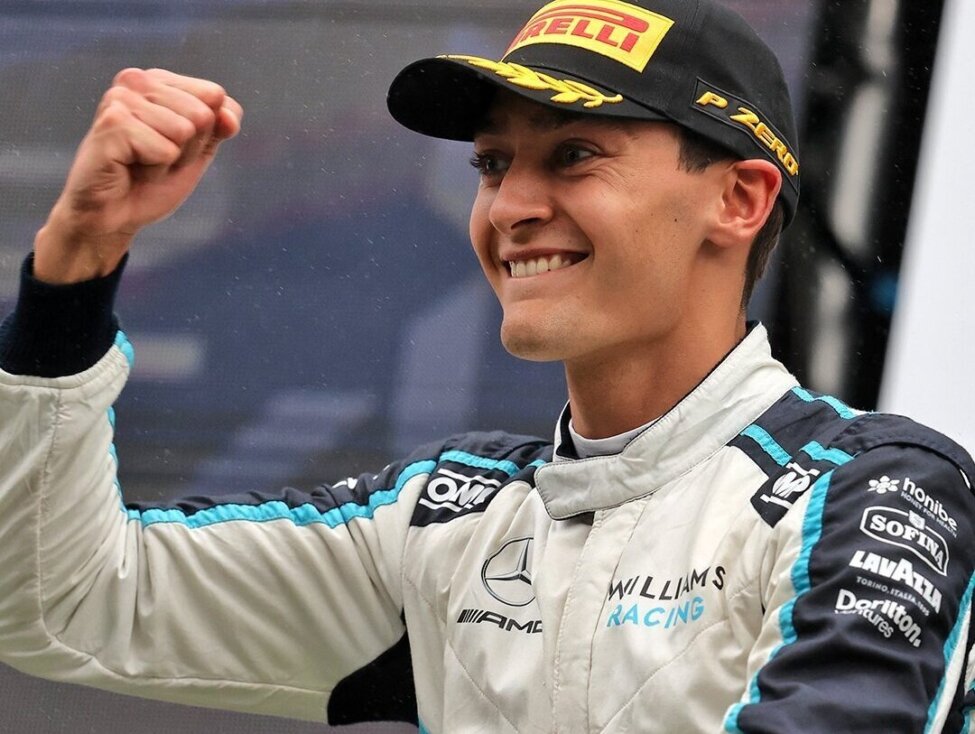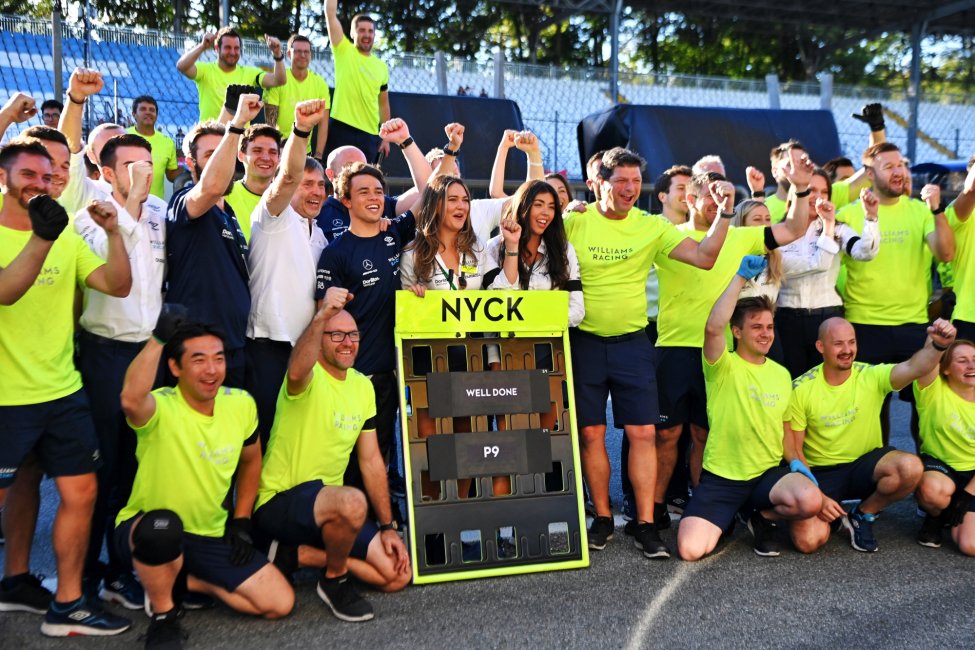
Williams Racing
Albon & SainzFollowing a strong 2023 season where the team finished seventh, the 2024 season proved to be very challenging. Due to underperforming, Logan Sargeant was replaced by Franco Colapinto for the final races. All three Williams drivers caused a record amount of damage to the cars. With a disappointing ninth place finish, the team is looking forward to a better 2025, with Alexander Albon and Carlos Sainz as the team's full-time drivers.
F1 season 2026
| WC Position | 5 |
| WC points | 0.0 |
| Podiums | 0 |
| Pole positions | 0 |
F1 history
| World titles | 9 |
| WC Points | 3774 |
| Podiums | 315 |
| Pole positions | 312 |
Origins of Williams Racing
Although the current Williams team started life back in 1977, its roots date back to the 1960s, when Frank Williams created Frank Williams Racing Cars. The squad failed to achieve much success, even after Canadian millionaire Walter Wolf entered the scene in 1976, leading to the outfit being rebranded as Wolf-Williams Racing.
Wolf opted to rename the team Walter Wolf Racing and remove Williams from his role as manager. This allowed Frank to move to Didcot and rebuild his team as Williams Grand Prix Engineering. Patrick Head co-founded the squad, and worked as Technical Director until 2004.
First F1 entry and rise up the ranks for Williams Racing
Williams entered a custom March 761 for the 1977 season, with Patrick Neve driving the team's lone entry starting from the Spanish Grand Prix. The Belgian driver failed to score a point, his best finish being seventh in Italy.
Head designed his first Williams car, the FW06, in the following year, with the team bringing in Alan Jones as their new driver. He scored their first points at the South African Grand Prix, finishing fourth. Jones improved on that in the United States, bringing home Williams' first podium with a second place. The team finished the year ninth in the Constructors' Championship with 11 points.
Jones was joined by Clay Regazzoni as Williams opted to field two cars in 1979. The Swiss driver almost claimed the outfit's debut win in Monaco, but finished less than a second behind race winner Jody Scheckter. That elusive first victory finally came at Williams' home race, the British Grand Prix, with Regazzoni finishing 25 seconds clear of the field.
That success continued at Hockenheim as Jones led the team's first 1-2 finish, before making it three in a row for Williams at the Austrian Grand Prix. The streak extended to four when Jones won comfortably ahead of Scheckter at Zandvoort, but the Ferrari driver ended Williams' run by taking the chequered flag at the Italian Grand Prix.
Jones added another win in Canada, finishing third in the Drivers' Championship behind champion Scheckter and his Ferrari teammate Gilles Villeneuve, while Williams ended the year second in the Constructors' Championship.
Reutemann partnered Jones in 1980, and the Australian wasted no time by winning the opening race of the season in Argentina. Jones clinched victory at another four races, including the final two of the season in Canada and the United States, to take the World Championship by 13 points over Brabham's Nelson Piquet. Williams also won their first Constructors' Championship, with 120 points to their name.
Jones and Reutemann scored four wins between them in the following year and, while both drivers finished behind champion Piquet in the Drivers' standings, Williams took the Constructors' Championship over Brabham. Jones retired in 1982, and was replaced by Keke Rosberg who had failed to score a point the previous year. Nevertheless, the Finn claimed the title despite only winning one race that season in Switzerland.
Honda engines
Frank Williams realised he needed the help of a major manufacturer to stay at the top of F1 and turned to Honda, who were developing a turbocharged V6 engine with the Spirit team.
Williams continued to use Ford power except for the final race in South Africa in 1983, and the full-time switch to Honda the following year proved unsuccessful. Rosberg won the Dallas Grand Prix with the FW09, but the team finished the year sixth with 25.5 points.
Now running with the yellow, blue and white Canon livery that stayed with the team until 1993, Head designed the FW10 in 1985 that used the carbon-fibre composite technology that McLaren pioneered. Nigel Mansell partnered Rosberg, with both drivers winning two races each to help Williams to finish third in the Constructors' Championship.
Frank Williams was involved in a road accident on the way to the airport following pre-season testing at Paul Ricard in March 1986. The incident left him paralysed from the waist down, and he didn't return to the pit lane for almost a year.
Despite his absence, Williams won nine races and took the Constructors' Championship. Mansell and Piquet just missed out on the Drivers' title, as Mansell suffered a left-rear tyre blowout at the season-ending Australian Grand Prix. Piquet was pitted as a precaution, allowing McLaren's Alain Prost to successfully defend his championship.
Piquet secured Williams-Honda's only Drivers' Championship the following year in 1987, with the Brazilian winning three races and finishing 15 points ahead of teammate Mansell in the standings. Although Williams took another Constructors' title, Honda opted to end their partnership in favour of a return to McLaren, as well as continuing with Lotus.
Renault engines
Without a major engine manufacturer, Williams switched to Judd engines in 1988. Piquet left for Lotus, with Riccardo Patrese brought in as his replacement. The team failed to register a win, and only scored 20 points.
In 1989, Williams secured an engine supply from Renault, though Mansell left for Ferrari and was replaced by Thierry Boutsen. However, the partnership got off to a rocky start, with both drivers retiring with engine issues. Boutsen secured Williams' first win with Renault power by leading a 1-2 finish in Canada, and the Belgian also won the Australian Grand Prix. Patrese outscored him at season's end, though, while Williams finished second as a team.
The two drivers returned in 1990, but the lone bright spots were Patrese's win at the San Marino Grand Prix and Boutsen's pole position in Hungary, as Williams finished the year down in fourth. Mansell returned in 1991 after Boutsen left for Ligier, and finished second to McLaren's Ayrton Senna in the standings. The British driver took five victories, while Patrese added another two to help Williams to a second place finish in the Constructors' Championship.
Williams dominate with Mansell then Prost
Mansell won the first five races of the 1992 season and didn't look back from there, as the Williams FW14B proved to be too much for the rest of the grid. He finished the year with nine victories, becoming the first driver to achieve this in a single F1 season, while also becoming the first Briton to win the championship since James Hunt in 1976. Teammate Patrese finished second in the standings, a full 52 points back.
Despite the success, there was upheaval at Williams prior to the 1993 campaign. Prost ended his year-long sabbatical, while Senna's contract with McLaren was also coming to a close, along with the team's deal with Honda. Both drivers were considered for a seat, but it went to the Prost, which then had a knock-on effect. Patrese left for Benetton to partner Michael Schumacher, while Mansell refused to drive with Prost, as the two were on poor terms from their brief time at Ferrari together.
Mansell left for Newman-Haas Racing in the CART Racing Series, while Prost had a provision put into his contract that gave him veto power on who the second driver at Williams was. He made it clear he did not want to race with Senna, who remained with McLaren for another year, and as a result Damon Hill was promoted from test driver.
The Williams FW15C proved to be a class above, thanks to active suspension and traction control systems that were beyond what other teams had. Prost won his debut race for the team in South Africa, finishing a minute ahead of Senna. The Frenchman took victory in seven of the opening 10 races, while Hill won the other three, though Williams failed to win any of the final six races. As a result, Prost clinched the title by 26 points over Senna, who overtook Hill in the standings, whilst Williams cruised to an easy Constructors' title.
Prost retires, Senna steps in but tragedy strikes
Prost's veto powers on the other Williams seat were only valid for the 1993 season, and as a result Senna was signed for 1994. Soon after the news, the Frenchman announced his retirement from motorsport.
Senna was the pre-season favourite given Williams' dominance during the previous two years but, with the FIA banning electronic drivers' aids such as active suspension, traction control and ABS, the FW16 was fast but difficult to drive.
As a result, Williams no longer held the advantage that set them apart from the rest of the grid, with the Benetton-Ford showing in testing that, while it wasn't as powerful a car, it was more nimble than the Williams.
Senna took pole at the opening two races, but failed to finish either of them, with Schumacher winning both. The season took on a different dynamic at Round 3 in San Marino, as the Brazilian took pole once again but was involved in a fatal crash on Lap 6. At the following race in Monaco, the team ran one car as a mark of respect to Senna.
Test driver David Coulthard was brought in as the Brazilian's replacement in Spain, a race where Hill claimed the team's first victory of the season. Schumacher was disqualified from the Belgian Grand Prix and banned for the next two races, allowing Hill to edge closer in the championship fight.
Mansell replaced Coulthard for the final three races, while Schumacher entered the final Grand Prix of the season in Australia with a one-point lead over Hill. However, midway through the race, the German clipped the outside of the wall at Turn 5.
When Schumacher recovered, Hill tried to make his way past, with the German turning into his rival and ending up in the wall. Hill's bent suspension forced him to retire as well, handing the title to the Benetton driver by one point. Williams would end the season with a third consecutive Constructors' Championship.
Coulthard became Hill's full-time teammate in 1995, but Williams were not able to match the Benetton-Renault pairing. Schumacher won nine of the 17 races, and took the championship by 33 points over Hill. While the two Williams drivers finished the year second and third in the standings with a combined five wins, it wasn't enough to deny Benetton the Constructors' Championship.
Hill and Villeneuve add to Williams' success
CART Series Champion Jacques Villeneuve joined the team in 1996, with Coulthard leaving for McLaren. The FW18 was the quickest car on the grid, and as a result the championship battle was between the Williams drivers of Villeneuve and Hill.
Hill won four of the first five races, with Villeneuve taking the other. Although the Canadian entered the final Grand Prix of the season in Japan with a chance to take the title, his DNF along with Hill's win handed the championship to the Briton. Despite the success and the Constructors' Championship, Hill wasn't re-signed and joined Arrows for 1997. Heinz-Harald Frentzen was brought in as his replacement.
While the German would only win one race during his two seasons with Williams, Villeneuve battled it out with Schumacher - now at Ferrari - for the 1997 title. Williams claimed their 100th win at the British Grand Prix, but Schumacher entered the final race of the season in Jerez with a one-point lead on Villeneuve. The two drivers collided on Lap 48, with the FIA later deeming the incident avoidable and disqualifying Schumacher from the championship, while Williams took a third consecutive Constructors' Championship.
The following two years saw Williams fall down the order as Renault ended their involvement in Formula 1 and designer Adrian Newey moved to McLaren. The team used Mecachrome engines, which were old, rebadged Renault F1 engines. Ferrari and McLaren battled over the title, while Williams failed to win a race and only finished on the podium three times.
Things didn't improve all that much the following year, where the team this time raced with Supertec engines, which were rebadged Mecachrome-Renault units. Villeneuve and Frentzen were replaced by Ralf Schumacher and Alex Zanardi, who had won the previous two CART Championships.
The German scored all three of the team's podiums, while Zanardi ended the year without a single point. As a result, Williams finished fifth in the Constructors' Championship, their lowest position in the 1990s. Zanardi and Williams agreed to terminate his contract at the end of the season, with the Italian moving back to CART.
Becoming BMW Williams
Williams signed a six-year deal with BMW that would see the German manufacturer supply engines and expertise. As part of the deal, Williams were to have one German driver, hence the Schumacher signing. The car was also made entirely blue and white.
Jenson Button replaced Zanardi for the 2000 season, though the first year of the BMW partnership failed to yield any victories. Schumacher did finish on the podium three times, though, to help Williams finish the year third in the Constructors' Championship.
Juan Pablo Montoya, who had spent the past two seasons in CART, joined the team in 2001, and as a result Button moved to Benetton to make room for the Colombian. Schumacher won three races, with Montoya adding a fourth at Monza, though they could have had more were it not for the FW23's reliability issues and some pit crew mistakes.
Both drivers returned in 2002, though their only victory came in Malaysia courtesy of Schumacher. It was one of only two non-Ferrari wins that season, as the Scuderia won 15 of the 17 races. Williams managed to finish second in the standings, 129 points back from the Scuderia.
Williams had their best title challenge since 1997 during the 2003 campaign, as Montoya and Schumacher both won two races each. However, Montoya ultimately finished third in the standings, 11 points behind Michael Schumacher. Ralf ended the year in fifth, while Williams beat McLaren to second in the Constructors' standings.
Montoya announced at the start of the 2004 season that he would be leaving for McLaren in 2005, while Williams had no answers for the dominant Ferrari, who won 15 of the 18 races. The team tried an innovative radical nose-cone design, known as the "Walrus-Nose", but it proved uncompetitive and was replaced by Hungary. Their lone win came via Montoya's triumph in Brazil, which proved to be Williams' last victory until the 2012 Spanish Grand Prix.
Schumacher left for Toyota in 2005, with the team bringing in Mark Webber and Nick Heidfeld as their new line-up. The relationship between BMW and Williams began to sour as well, with both sides blaming each other for their inability to challenge for the title. Although BMW were contracted to supply Williams with engines until 2009, the deteriorating relationship factored into BMW Motorsport's decision to buy Sauber and rebrand it to feature the BMW name.
Mixed fortunes in the late 2000s
Williams opted for Cosworth engines in 2006, and the team started the season well, with both drivers - Nico Rosberg and Webber - finishing in the points for the opening race. However, the team suffered through 20 retirements out of 36 starts between both cars. It marked the first time that Williams had failed to finish on the podium since their debut season in 1977.
As a result, the outfit switched to Toyota engines the following year, and Alexander Wurz joined to replace Webber. The Austrian finished on the podium in Canada, giving Williams their first podium since the 2005 European Grand Prix. Williams ended the year fourth in the standings, thanks to Rosberg finishing with 20 points.
In 2008, Wurz retired and was replaced by Kazuki Nakajima, who had made his debut in Brazil the previous year. While Rosberg finished on the podium twice, Williams struggled in high-speed corners and quickly focused their attentions on their 2009 car, and as a result finished in eighth.
A return to Cosworth power followed in 2010 along with a new driver line-up. Rubens Barrichello joined from Brawn GP, while Nico Hulkenberg was promoted from test driver. The team finished sixth in the standings, though managed to take their first pole in over five years thanks to Hulkenberg's efforts in variable conditions in Brazil.
Pastor Maldonado replaced the German in 2011, but Williams had one of their worst seasons to date. Their best results were two ninth places for Barrichello and a 10th for Maldonado.
Williams reunited with Renault in 2012, with Maldonado now partnered by Bruno Senna. The Venezuelan took his only F1 victory at the Spanish Grand Prix, Williams' first since the 2004 Brazilian Grand Prix. This did not prevent them from finishing the season ninth out of 12 teams, though. Valtteri Bottas took Senna's spot in 2013, but the team finished the year with just five points in the Constructors' Championship.
Return to form with Mercedes before more struggles
Having failed to hit the same heights with Renault that they did in the 1990s, Williams signed a contract with Mercedes to supply engines ahead of the 2014 season. Bottas was retained, and partnered by Felipe Massa.
The Brazilian took pole at the Austrian Grand Prix, the only non-Mercedes driver to do so all season, with Bottas starting alongside him. It was Williams' first front row lockout since the 2003 German Grand Prix. A double podium in Abu Dhabi helped the squad to finish third in the standings, and they also finished third in the following year as well, with Massa and Bottas splitting four podium finishes between them.
Bottas finished third at the 2016 Canadian Grand Prix, marking Williams' lone podium finish of the season. The team still managed to end the year fifth in the standings, but they scored 119 fewer points than in 2015.
The 2017 campaign saw Bottas leave for Mercedes, with Lance Stroll brought in as his replacement. While the Canadian finished an impressive third in Azerbaijan, Williams ended the year in fifth with 83 points. Things really fell off in 2018, as Williams finished last in the Constructors' Championship with just seven points, mostly due to a lack of pace.
George Russell and Robert Kubica were the driver line-up for 2019 but managed just one point, while Russell and rookie Nicholas Latifi were held pointless in 2020.
New ownership and management
With the team struggling for results on track, Williams were acquired by US investment group Dorilton Capital for €152 million in August 2020. The fee included the settling of debts as well as the promise that the team would keep its UK-base and Williams name.
Although Claire Williams was offered the chance to stay on as Team Principal, she announced her departure effective after the Italian Grand Prix. It marked the first time in the history of the team that the Williams family weren't at the helm of operations. Jost Capitao was confirmed as the new CEO in December 2020.
Signs of progress in 2021 for Williams
The 2021 campaign didn't necessarily get off to the best start for Williams, with Russell becoming involved in some early drama at the second race of the year in Imola. The Briton collided with Bottas after driving on a wet patch of track and losing control of his car whilst trying to overtake. This caused both cars to retire and also prompted a red flag, as well as a fiery response from Russell.
He accused Bottas of "trying to kill him" in the immediate aftermath but later retracted the comment, offering a public apology to his teams and fans via an Instagram post.
Eventually, though, there were signs of progress for the team. Russell managed to get his car into Q2 during qualifying on more than one occasion. At his home event at Silverstone, the Briton memorably reached Q3, meaning that he lined up in eighth for Saturday's Sprint race.
At the following race weekend of the Hungarian Grand Prix, both Russell and Latifi scored points on what proved to be an emotional day for the Grove-basd outfit. Each driver took points again at the rain-affected Belgian Grand Prix, where half points were awarded due to the race only running for one full lap behind the Safety Car. With Russell having again impressed in qualifying to line up P2, this gave him his debut podium finish in F1.
There were further points finishes for Russell in Italy and Russia, but the latter stages of the season proved to be more challenging for Williams. Both drivers failed to finish the season-closing Abu Dhabi Grand Prix and, in Latifi's case, this brought with it some controversy.
The Canadian crashed out of the race with just a few laps remaining, which then triggered a Safety Car period. This had a dramatic effect on the title battle between Max Verstappen and Lewis Hamilton, with Verstappen able to pit for fresh Soft tyres and overtake Hamilton on the last lap, handing the Dutchman victory along with the World Championship.
Following the much-discussed events, Latifi revealed that he had received "hate, abuse and even death threats" on social media.
Despite this difficult end to 2021, Williams still managed to finish eighth in the Constructors' Championship with 23 points, putting them ahead of Alfa Romeo and Haas.
Transitional Williams team fail to capitalise on technical regulation changes
As well as new regulations being introduced into the sport, 2022 also marked a change in terms of driver line-up at Williams. Alexander Albon joined the team to replace Russell, who made the step up to Mercedes to become Hamilton's teammate.
Jenson Button also continued in his senior advisor role at the team, with Latifi having praised the former F1 driver's contribution.
Despite the technical regulations creating opportunities for teams to make leaps forward, Williams were unable to mount any sustained challenges for points.
Albon immediately took control of the team and asserted his authority as the 'number one' driver with point scores in Australia (thanks to an obscure pit strategy) and Miami.
Set ups which focussed on top speed yielded another point in Belgium, and a similar configuration was key to a remarkable ninth place F1 debut for Nyck de Vries, who substituted for the unwell Albon at the Italian GP, effectively securing his seat on the grid with AlphaTauri for 2023.
Whilst Latifi underperformed for much of the year he profited from excellent wet-weather tyre tactics to claim P9 at the Japanese GP, but it was ultimately not enough to prevent him from being dropped at the end of the season.
The end of Williams' season mostly centred around providing development driver Logan Sargeant with free practice outings to ensure he would have enough superlicence points to claim a place on the 2023 grid.
Can Vowles push the team forward in 2023?
Ahead of the 2023 season, Williams announced the signing of long-time Mercedes man James Vowles, who was brought in to replace Jost Capito as Team Principal.
With Williams also hoping for gains in the driver department, Albon and American rookie Sargeant will be hoping to start an upwards trajectory for the legendary F1 team.
A strong 2023 season and the objectives for 2024
After a mediocre 2022 season, the team started early in the season to focus on the development of the car for 2023. The car seemed to have been successfully improved, allowing Alexander Albon to accumulate a total of 27 points for the British team during the season. Logan Sargeant also secured his first point for Williams Racing in F1 during his home race in Austin, United States.
This was ultimately enough to finish seventh in the Constructors' Championship, earning the team a substantial amount of prize money, namely 87 million dollars.
Williams suffered a disappointing 2024 season
After a solid seventh place finish in the previous year, Williams experienced a significant downturn in 2024. Drivers incurred a record-breaking €13 million in damages. Following a major crash at the Dutch Grand Prix, the American driver was replaced by the Argentine. Colapinto took over Sargeant's seat.
The team managed to score only seventeen points this season, resulting in a ninth-place finish in the championship. With the budget cap and the high cost of damages, it will be difficult to develop the car effectively with the reduced prize money compared to 2023.
However, the team is strengthening for 2025 with Carlos Sainz joining as a full-time driver alongside Alexander Albon. With this driver pairing, Williams hopes to perform well next year.
Don't miss out on any of the Formula 1 action thanks to this handy 2026 F1 calendar that can be easily loaded into your smartphone or PC.
Download the calenderWilliams Racing news

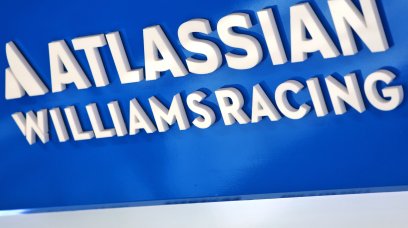


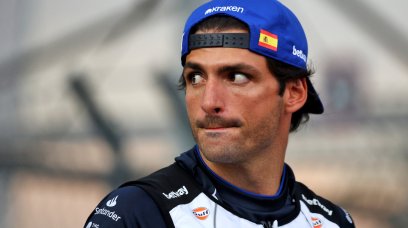
Williams Racing videos

